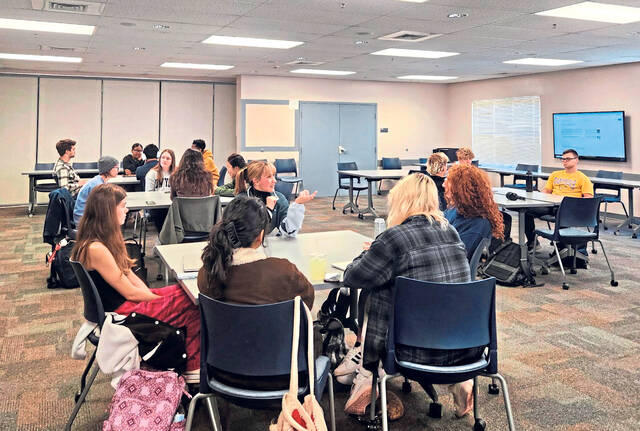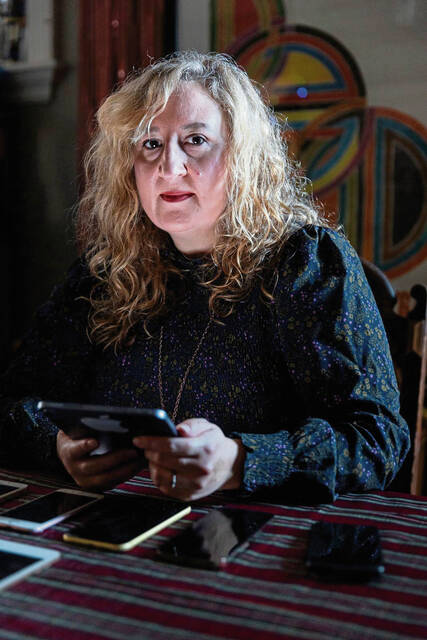Social media's impact on children topic of panel discussion on 'Anxious Generation'
University of Pittsburgh at Greensburg communications professor Jessica Ghilani likens the design of social media platforms to casinos without windows.
The introduction of algorithmic sorting to Facebook in 2009 paved the way for social media platforms to generate endless streams of content for users — a system Ghilani describes as habit-forming.
“They want very much for us to use them unthinkingly, because if we use them with purpose, if we use them in a way that’s very aware, we’ll probably not spend as much time,” said Ghilani, a graduate of Pitt’s main campus in Oakland who has taught at the university for 15 years. “I liken it to the way that casinos have no windows.
“When we see the amount of time, when we have those windows put into the casino, suddenly we realize ‘Oh, it’s dark. How is it dark already? How did that amount of time pass so quickly?’ ”
It’s a topic Ghilani regularly discusses with students in her mass communication in society course. And on Oct. 27, the surrounding community will have an opportunity to sit in on a similar discussion.
Westmoreland Reads — an initiative launched by Pitt-Greensburg Professor Sheila Confer — invited students and local residents this year to read “The Anxious Generation” by New York University professor and social psychologist Jonathan Haidt.
The 2024 book is a critically acclaimed national bestseller that argues social media and technology use can have an impact on children’s development and mental health.
Ghilani will be among a panel unpacking the research, problems and potential solutions identified in the book at 7 p.m. Oct. 27 in the university’s Ferguson Theater.
Also on the panel will be Pitt-Greensburg counseling director Gayle Pamerleau; Hempfield Area Superintendent Mark Holtzman and guidance counselor Jaimie Sebastianelli; Westmoreland County Community College adjunct psychology professor Tonuia Smith; Pitt-Greensburg alumnus Veronica Braman; and Pitt-Greensburg student Zakery Wiles.
Book sparks discussion
The most impactful part of the book, Ghilani said, is its ability to foster conversations about the dangers of social media.
“I’m glad that this book exists,” she said, “because I do think that it helps people think more critically about how they use tools that have been designed deliberately to get us to not think while we use them or to not think in active ways about our time and the toll that using them takes on our emotional state.”
But Ghilani admits she has found some holes in the book’s research and arguments — specifically its lack of comprehensive media effects research.
The book, for example, suggests technology companies need to make changes to social media platform designs to make them less addictive.
Ghilani is doubtful technology companies will make these changes unless they are legally enforced.
“I think in the absence of meaningful regulation, they will not of their own volition make the consequential decisions they need to make to actually protect kids,” she said.
Some legislators are already taking action on this front.
California Gov. Gavin Newsom signed into law last fall legislation that will make it illegal for social media platforms to knowingly provide addictive feeds to children without parental consent, according to the Associated Press. It will go into effect in 2027.
New York passed similar legislation in June 2024, AP reported.
Superintendent: Technology is not ‘the primary teaching and learning tool’
Holtzman similarly had mixed feelings about the book, questioning Haidt’s proposal to ban cellphones in classrooms.
“Unfortunately, that creates some defiance by children sometimes and parents that are not happy with those arrangements,” said Holtzman, hired by Hempfield in 2024.
Holtzman also questions Haidt’s argument technology and social media use is generating mental health diagnoses among children.
“I think that, oftentimes, we’re very quick to label children and people in society,” Holtzman said. “We are not necessarily just accepting that somebody’s had a couple of bad days or a bad week.
“Obviously, there’s going to be times where people need support, therapy, medications, ways to solve problems,” he said. “But there are also times when people need to have the room and flexibility to work through whatever struggles they’re having without a label.”
Holtzman is an advocate for responsible technology use in the classroom — as a tool for both students and teachers.
Technological advancements are expected to play a large role in the district’s high school renovation. The school board in May advanced a schematic design for the renovated building, which will add a two-story innovation center to the front of the high school.
But technology is not the end-all, he said.
“I do think that there is a time and place where that engagement, hands-on experience in schools need to occur without the use of technology. Innovation is not technology. Innovation is nontraditional teaching and learning.
“Technology could be part of innovation, but there doesn’t always need to be technology to be innovative.”
Editor’s note: The original version of the story stated the wrong campus that University of Pittsburgh at Greensburg communications professor Jessica Ghilani attended and graduated from.
Quincey Reese is a TribLive reporter covering the Greensburg and Hempfield areas. She also does reporting for the Penn-Trafford Star. A Penn Township native, she joined the Trib in 2023 after working as a Jim Borden Scholarship intern at the company for two summers. She can be reached at qreese@triblive.com.
Remove the ads from your TribLIVE reading experience but still support the journalists who create the content with TribLIVE Ad-Free.


